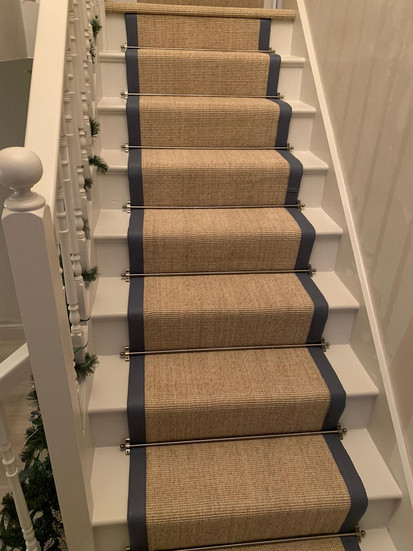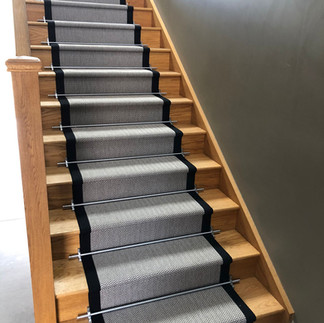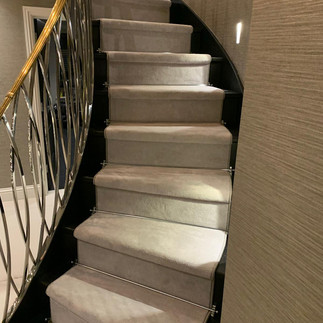How to design your dream stair runner
- Floor Design Wetherby

- Dec 5, 2024
- 7 min read
A stair runner is a key element in home design, that can dramatically transform both the aesthetics and functionality of your staircase. Whether you are renovating an existing staircase or building a new home, a custom-designed stair runner can be a game-changer. This blog will explore the benefits of a stair runner, important considerations to keep in mind when designing one, and a few tips for creating your dream stair runner.
What Is a Stair Runner?
A stair runner is a piece of carpet that runs down the centre of a staircase. It only partially covers the width of the staircase and is secured by gripper rods like a traditional stair carpet. Stair runners are different from fully fitted stair carpets because they leave the edges of the stairs exposed, providing a more streamlined look while still offering comfort and protection.
Stair runners come in various materials, colours, textures, and patterns. The options are endless, allowing you to create a design that reflects your personal style and complements the surrounding décor.
Things to Consider When Designing Your Dream Stair Runner
The stair runner design process can be fun and creative, but there are practical considerations that must be taken into account to ensure a beautiful and functional result.
1. Stair Dimensions
Before you start selecting fabrics, colours, or patterns, it’s essential to consider the width of your stair runner. Take note of the width of the staircase, as this will help you to determine the desired width of your finished runner. Pay special attention to any newel posts that are narrower than the main stairwell as the runner will need to be narrow enough to bypass these sections.
It is important to leave enough space at each side of the stair runner to leave some of the stair structure exposed, whilst still leaving plenty of room to comfortably walk on. If you opt for a bound edge finish, it is important to remember that this is wrapped around each edge of the carpet and sewn in place, effectively taking up around 10cm total of the finished runner width. If you chose a bound runner to be finished 70cm wide for example, then you would likely end up with around 60cm of carpet visible and 5cm at each side of binding showing.
The typical stair runner often falls between 60cm - 70cm wide for the average staircase that is around 80cm wide in total.
2. Carpet Selection
The material you choose for your stair runner will affect both its durability and appearance. Different materials offer different benefits, so consider how your staircase is used, as well as your lifestyle, when making a selection.
Wool: Wool is a popular choice for stair runners because it’s durable, soft, and naturally stain-resistant. Many wool carpets are made in loop or flatweave designs that create texture and add additional interest. Some of our most popular runner choices consist of wool flatweaves in a herringbone pattern, that are not only striking in appearance, but also extremely hard wearing.
Nylon & Other Synthetic Fibres: If you’re looking for a luxurious touch, many man made fibres offer a sophisticated and elegant appearance that are soft in feel. However, they require more maintenance to retain the pile structure and are not as durable as wool or sisal carpets. Thicker pile carpets in lesser quality man made materials such as polypropylene and polyester are more prone to flattening and the carpet pile matting together, which we do not recommend on stairs. If this is the look you desire, then we recommend a shorter pile high quality nylon carpet instead.
Sisal: For a more natural look, sisal stair runners offer a textured appearance that complements coastal or rustic interiors. These materials are durable but can be rough underfoot.
3. Style and Design
The style of your stair runner should complement the overall design of your home. When choosing a style, consider the existing décor and colour palette of the room where the staircase is located.
Solid Colours: Solid-coloured stair runners are classic and versatile. They can be used to create a subtle, refined look or to introduce a pop of colour to an otherwise neutral space. Popular choices include shades of beige, grey, and brown.
Patterns: If you want to make a bold statement, opt for patterned stair runners. Flatweave designs such as chevrons and stripes can all add visual interest to your staircase. When choosing a pattern, be mindful of the overall theme of your home. For instance, a classic herringbone pattern works well in traditional or modern settings, while a bold floral print may suit eclectic or bohemian interiors.
Texture: The texture of the stair runner can also play a major role in its appearance. Plush, thicker materials create a luxurious and cosy look, while flatwoven or low-pile designs offer a more understated and streamlined aesthetic that is more practical and hardwearing.
4. Colour Co'ordination
Choosing the right colour for your stair runner is crucial to creating a cohesive look. The colour should either complement or contrast with the surrounding elements in your home, such as the walls, flooring, and furniture.
If you have light-coloured walls and furniture, a darker runner will add contrast and create a focal point on the stairs.
Conversely, if your home features dark or bold tones, a lighter runner can provide balance and brighten up the space.
Neutral shades like beige, taupe, and grey are versatile and can work in almost any setting, while bold hues like emerald green or navy can add a pop of colour.
5. Installation Considerations
Once you’ve designed your dream stair runner, it’s time to think about other installation considerations. One such consideration is how you intend the carpet to be installed down each riser. There are two common techniques used to do this that both look great:

Waterfall Effect - Where the carpet is pulled over the nosing in a straight line down to the corner of the tread and riser. This is the cleanest finish and we recommend this for all twist and loop pile carpets.

Pinned Under Nosing's - Where the carpet is pulled tight around the form of the nosing and pinned on the underside of the lip so that the carpet lies flat against the riser. This upholstered method works well with flatweave and sisal carpets, but means additional length is needed on the carpet in order to wrap each nosing.
Another installation consideration is how you wish to carpet over any half landings or quarter turns you may have. The cheapest and easiest method of installation here is to fully fit any half landings or quarter turns, whilst finishing them by capping the carpet under the nosing before restarting your runner on the riser leading down to the next section of stairs:

The alternative to this is to shape the runner to continue along half landings and quarter turns so that the runner is uninterrupted from top to bottom. This method always requires two visits from the fitters as they have to cut and shape the runner on site prior to the runner edging being finished, so it is often more costly:

Lastly, before choosing to have a runner installed, it is important to know that your existing staircase is in good condition and can be left bare or painted to a good standard before having your runner fitted. If you have fully fit carpets down already, it is always worth removing a section to see the condition of the stairs before deciding to go down the route of a stair runner. If you are painting the woodwork of the stairs, make sure you leave enough time for the paint to fully cure before the installation of your stair runner.
6. Runner Edging
Runners edges can be finished in a number of ways, depending on your style preference and budget.

The most popular and durable method of edging the width of stair runners is to use a separate textile to bind the edges. Multiple fabrics can be used for this, including leather (Max length is around 40-120cm so joins will be required), faux leather and linen, but the most popular is a cotton binding. The binding is folded around the edge of the cut carpet and sewn into position to create a trendy and durable finish. Often contrasting colours are used to highlight the runner and make it pop from the staircase underneath.

Another method of finishing the runner edging is to have the edges whipped using a spool of yarn. This is generally cheaper than binding the runner edges, but the whipped edge can start to pill over time if not properly maintained. Often a complimentary colour yarn will be chosen to create a subtle finish rather than a bold or contrasting edging that you often find with bound runners.
The last method of edging is to hem the edge of the runner by turning the carpet over on itself and gluing it into position. This is the least common method of the three and requires more width on the carpet to allow the carpet to be folded back on itself. It also creates a more bulky edge to the sides of the runner and may not be as hard wearing as the other options.
7. Stair Rods
In times gone by, stair rods would be used to hold the stair runner in position and stop the carpets from becoming baggy or rucked up. Nowadays the stair rods are used for purely aesthetic purposes to create an additional feature and added design element. stair rods are generally better suited to period properties and more traditional decors, however are becoming increasingly popular in more contemporary settings. stair rods can add a lot of additional cost to the project and it is worth bearing in mind that they are screwed into your woodwork, so you will be left with holes if you ever decide to have them removed.
There are a lot of colours and styles of stair rod available, but our preferred option is the Jubilee stair rods from Stairrods Ltd.
Conclusion
Designing you're dream stair runner involves more than just picking out a fabric or pattern. It’s about balancing aesthetics with functionality to create a staircase that is not only beautiful but also safe, comfortable, and durable. By carefully considering the material, design, and dimensions of your runner, you can achieve a cohesive look that enhances your home’s overall design while serving practical purposes.
A well-chosen stair runner can be a transformative addition to your home, offering a blend of style, comfort, and protection. Whether you opt for a luxurious wool runner or a simple, contemporary design, the right stair runner can turn your staircase into a statement piece and elevate the entire feel of your space.
If your still unsure, why not pop down to our Wetherby showroom to see our mock up staircase fitted from three separate runners in three different styles and designs. Chat to our expert design team who can offer advice and support, or even use the carpet, binding and stair rod samples in store to make up your own personalised mood board.
Happy designing!




















































Comments